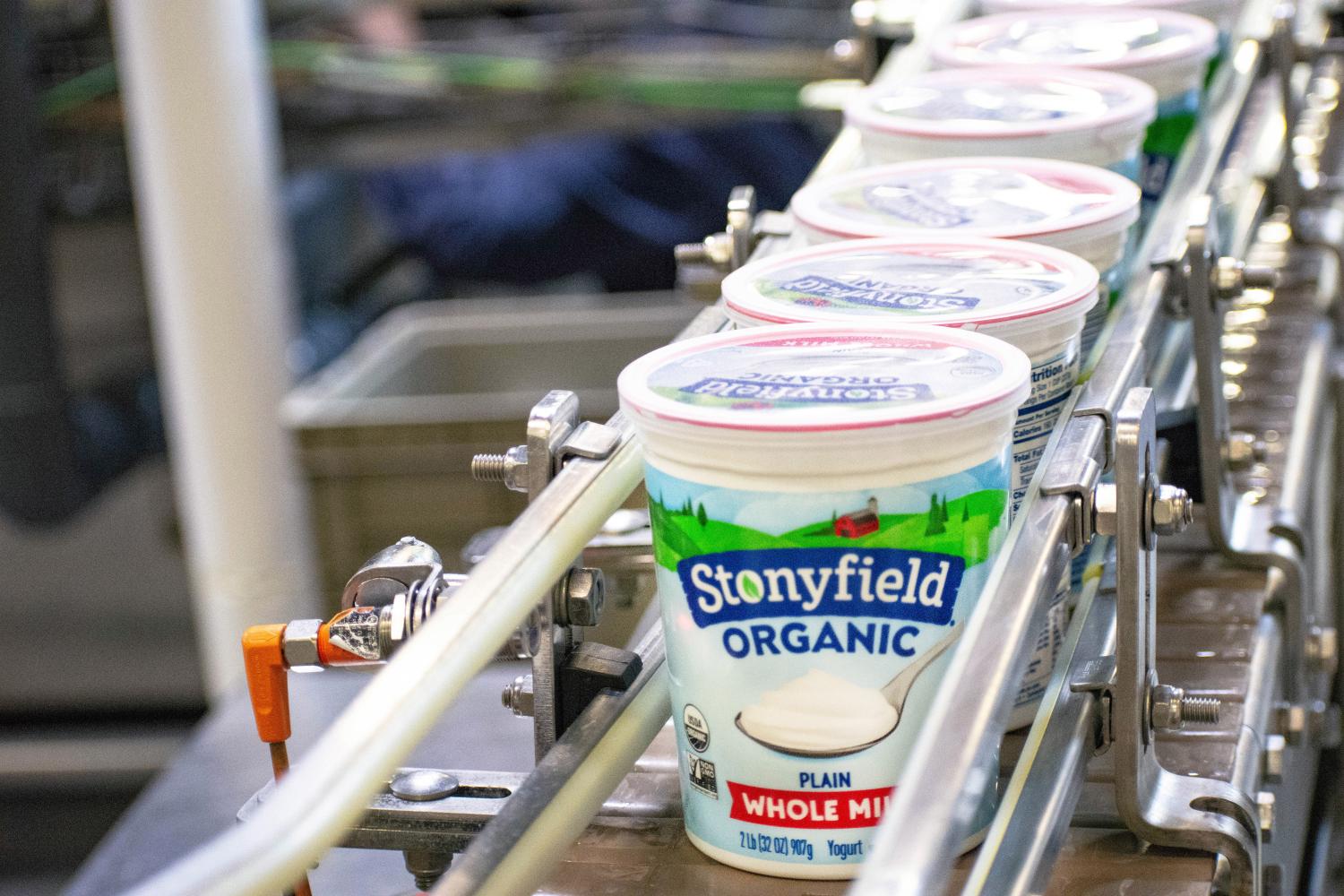Freezer market hots up with Unilever’s energy efficient cabinets


Figures just out demonstrate how significant advances in refrigeration technology have resulted in a new generation of ice cream freezer cabinets capable of a 70% energy reduction.
Unilever scientists have developed hyper efficient point-of-sale freezer technology to replace current models that already deliver industry leading energy reductions of up to 50%. Once rolled out the new model has the potential to deliver savings equivalent to removing half a million cars* from the road network.
Unilever Chief Sustainability Officer, Jeff Seabright commented: “Thanks to the radical approach of our scientists Wall’s ice cream cabinets across the world are driving down energy use while driving up design and innovation standards. As the market leader in ice cream and cabinet refrigeration, the size of the reductions announced coupled with our scale allows us to make a positive difference in reducing environmental impact.
"Enjoying an ice cream or two in summer is what fond memories are made of. Now that pleasurable experience is enhanced with added climate friendly benefits to broaden those smiles.”
3p Weekend: 7 Companies Investing in Sustainable Packaging


As waste continues to pile up in our landfills, a growing number of companies are taking a second look at product packaging and devising creative ways to cut back. From mushrooms and potatoes to the quest for a recyclable toothpaste tube, this week we're tipping our hats to seven companies that are leading the charge in sustainable packaging design.
1. Dell
After introducing bamboo packaging for some of its smaller devices in 2008, Dell announced in 2010 that it would start shipping other products in packaging made from a fungus material, combined with commercial agricultural waste. Both packaging designs are renewable and biodegradable, and they also help the company cut energy use. Last year, Dell took things even further by announcing plans to source 100 percent of packaging from sustainable materials that will be recyclable or compostable by 2020.
2. Amazon
Amazon's battle against “wrap rage” – the frustration of trying to open a seemingly impenetrable package to get to the product inside – is rolling ahead at full force. Last year, the online retail giant announced that its Frustration-Free Packaging initiative, a five-year effort to liberate products from hermetically sealed clamshell cases and plastic-coated steel-wire ties, now offers more than 200,000 items. To date, Amazon has shipped over 75 million of these items to 175 countries, the company said.
3. REI
TriplePundit pinpointed REI as a packaging trailblazer back in 2011. Key innovations have since helped the brand reduce consumer packaging by 36 percent – designing out more than 1.4 million pounds of waste, the company said. “We must go beyond the traditional ‘reduce, reuse, recycle’ model to eliminate waste at the front end of the manufacturing process,” the company states in the overview of its waste and recycling strategy. “And, we must carefully examine and reengineer practices attached with waste generation throughout our operations.”
4. Stonyfield Farm
Each year, Stonyfield Farm sells 200 million of its “YoBaby” and “YoKids” individual, 4-ounce yogurt cups (they’re sold in multipacks of four). This makes up 27 percent, by weight, of all its products sold each year. After customer complaints about health risks and lack of recycling options for its polystyrene yogurt cups, the company switched over to corn-based polylactic acid (PLA). Although PLA comes with its own set of problems, the company was able to significantly reduce conventional plastic use by making the change.
5.Tom's of Maine
As Dell explores bio-based options like mushrooms and bamboo, Tom’s of Maine is tinkering with potato starch for some its polylactic acid (PLA) packaging. Potatoes are a huge part of Maine’s farming sector, and the company has a long-term opportunity to divert food waste or crops that are below food-grade from landfills and churn them into bio-plastic resin. Tom's pinpointed its mouthwash bottles and deodorant canisters as good candidates for the use of potato-based PLA initially.
6. Colgate-Palmolive
Earlier this year, Colgate-Palmolive committed to making 100 percent of its packaging fully recyclable for three out of four product categories (home, pet and personal care) by 2020. Colgate has also committed to developing a completely recyclable toothpaste tube or package. Additionally, the company agreed to increase the average recycled content of its packaging from 40 percent to 50 percent, and reduce or eliminate the use of PVC — a hard-to-recycle resin — in packaging.
7. Puma
Puma has been working for years to develop more sustainable packaging across the board. It swapped out a hard-to-recycle plastic resin in favor of recycled paper for its sandal hangers. It also famously eliminated shoeboxes back in 2010 by introducing its 'Clever Little Bag' - a reusable bag with two cardboard inserts to hold shoes in place. Even with the inserts, the new packaging design dramatically reduces paper use and saves more than a million liters of fuel oil annually compared to a traditional shoebox, according to a Puma Lifecycle Assessment.
Image courtesy of Stonyfield Farm
Sponging Up Solar Energy


Leave it to those smarties at MIT to come up with something that sounds more like science fiction than reality: a new “material structure” that generates steam by soaking up the sun's rays.
As reported last week by Science Daily, this sponge-like structure is a layer of graphite flakes and an underlying carbon foam, which all works to create a “porous, insulating material structure that floats on water. When sunlight hits the structure's surface, it creates a hotspot in the graphite, drawing water up through the material's pores, where it evaporates as steam. The brighter the light, the more steam is generated.”
Could this mean a return to the age of steam? Let’s not get too far ahead of ourselves. "Steam is important for desalination, hygiene systems and sterilization," Hadi Ghasemi, who led the development of the structure, says in the article. Ghasemi is a postdoc in MIT’s Department of Mechanical Engineering. "Especially in remote areas where the sun is the only source of energy, if you can generate steam with solar energy, it would be very useful," he adds.
Ghasemi and mechanical engineering department head Gang Chen, along with five others at MIT, provided on the details of the new steam-generating structure in the journal Nature Communications, in a report entitled Solar steam generation by heat localization.
The journal abstract says that steam generation using solar energy currently “is based on heating bulk liquid to high temperatures” by using huge fields of mirrors or lenses that concentrate the incoming sunlight. This approach requires “either costly high optical concentrations leading to heat loss by the hot bulk liquid and heated surfaces or vacuum.”
New solar receiver concepts such as porous volumetric receivers or nanofluids have been proposed to decrease these heat losses. But initiating these reactions requires very intense solar energy -- about 1,000 times that of an average sunny day.
Thus the new structure developed by the MIT research team “provides a novel approach to harvesting solar energy for a broad range of phase-change applications,” the abstract says. It generates steam at a solar intensity of about 10 times that of a sunny day, which is the lowest optical concentration reported thus far, the Science Daily article says. The implication, the researchers say, is that steam-generating applications can function with lower sunlight concentration and less-expensive tracking systems.
"This is a huge advantage in cost-reduction," Ghasemi says. "That's exciting for us because we've come up with a new approach to solar steam generation."
After trying multiple materials, he settled on a thin, double-layered, disc-shaped structure. Its top layer is made from graphite that the researchers exfoliated by placing the material in a microwave. The effect, Chen says, is "just like popcorn": The graphite bubbles up, forming a nest of flakes. The result is a highly porous material that can better absorb and retain solar energy.
Sponges! Microwaves! Popcorn! Foam! Flakes! Exfoliation! Solar steampunk technology shines on.
Image credit: From the MIT report, courtesy of the researchers.
Cargill Adopts a More Sustainable Palm Oil Policy


The calls for companies to become more ethical when it comes to the sourcing of palm oil have grown even louder in recent months. With hydrogenated fats largely disappearing over health concerns, in addition to the surging demand worldwide for packaged foods and personal care products, the thirst for palm oil continues to grow rapidly. Companies who remain silent on responsible palm find themselves on the outside looking in, and will face more criticism from environmentalists and human rights activists. Cargill was one of those firms.
That has changed. The $137 billion company recently issued a new sustainable palm oil policy, a significant victory considering Cargill is a privately-held firm and not necessarily subjected to shareholder and stakeholder pressure to the degree a public company would face. NGOs such as the Rainforest Action Network have long complained about Cargill’s operations even though the company joined RSPO (Roundtable on Sustainable Palm Oil) in 2004. Additional watchdogs including the Union of Concerned Scientists have kept the pressure on consumer packaged goods and food processing companies to disclose their performance on palm oil sourcing — a difficult task when it comes to keeping private companies such as Cargill accountable because they often disclose far less information on how they conduct their business.
According to a memo recently released by Cargill, the company will work on the three pillars of sustainable palm oil production. First, the company will develop a traceable palm oil supply chain with a zero-deforestation policy. That will include a commitment to no future palm oil cultivation on peat soils, the massive carbon sinks located within tropical rainforests that end up contributing to the globe’s greenhouse gas emissions when exploited. Finally, Cargill has stated they will not source palm oil from areas where indigenous peoples have been exploited — an important step as the human cost of families who have lost their land rights due to industrialized palm oil production reveals the ugly side of this growing industry.
The key to whether Cargill actually follows through on these promises is transparency. The company claims it will start issuing annual updates about the progress of its new palm oil policy before the end of this year. A semi-annual progress report will be released in September, and meanwhile Cargill has committed to filing annual reports to the RSPO as required from member companies. And in a nod to human rights advocates, the company will prohibit its suppliers from using any forced or illegal labor — including that of course, involving children. Cargill has also said it will include small landholders’ palm fruit within their supply chain, but did not offer a specific percentage or deadline of when this would occur. Considering the environmental destruction that has resulted from turning rain forest into a palm oil monoculture, more action by Cargill and its peer companies are needed.
Many will say Cargill’s policy does not go far enough compared to stops other firms have taken. Indeed, companies excel at promising and providing frameworks when it comes to new environmental and social policies: the difficulty will be in the execution. But the deforestation resulting from ramped up palm oil production will not stop overnight, so the engagement of firms such as Cargill is necessary to raise awareness and nudge companies in all sectors to take responsible palm oil sourcing seriously.
Image credit: Wikipedia (Martin H.)
Leon Kaye has lived in Abu Dhabi for the past year and is on his way back to California. Follow him on Instagram and Twitter.
New World Bank Policies Potentially Devestating to Poor, Indigenous People


It looks like the World Bank is succumbing to budgetary pressures and choosing to neglect its human rights responsibilities as the world’s largest and most influential development bank.
Proposed revisions to the World Bank’s Safeguard Policies and Environment and Social Framework -- which are meant to protect people and the environment in the investment projects that the World Bank finances -- leaked last week and were immediately and uniformly criticized as potentially devastating to indigenous people, the poor and the environment.
On July 28, 99 non-governmental organizations and civil society networks across Asia, Africa, Latin America, North America and Europe sent a letter to the World Bank’s board, urging it not to adopt the draft. Yet, despite the viscerally negative reaction of rights groups around the world, the draft was cleared by the World Bank Board’s Committee on Development Effectiveness on July 30, and it will now be subject to a period of broad public consultations.
Indigenous people's rights
The prevailing criticism of the draft is that it “moves from [a framework] based on compliance with set processes and standards, to one of vague and open-ended guidance.” Perhaps the most offensive example of this, according to Bank watchdogs and rights groups, is the change the draft makes to the application of standards regarding “indigenous peoples.”
The old standard governing the rights of indigenous peoples required governments borrowing funds from the Bank (hereinafter referred to simply as “borrowers”) to obtain free, prior and informed consent from identified indigenous populations in the project area; conduct an impact assessment of the project; prepare and disseminate a plan about how to handle and mitigate those impacts; and, monitor the project on an ongoing basis.
The revised standard, Environmental and Social Standard 7 (ESS7), leaves these procedures in place in most instances; however, in an effort to “address implementation challenges and consolidate a range of stakeholder views,” the new standard provides an “out.” ESS7 states that, “where identifying Indigenous Peoples would exacerbate ethnic tension or be inconsistent with the provisions of the national constitution, project impacts on Indigenous Peoples may be addressed through the application of” other (read: less stringent) standards.
Moreover, there is no standard governing the determination of whether an opt-out is justified in a particular case. Rather, “The Bank will have the sole responsibility for determining the validity of the Borrower's concerns, and may use whatever means the Bank deems appropriate to do so,...” Thus, the criticism goes, where a borrower simply does not want to be burdened with the rigorous indigenous peoples’ standards, it may simply attempt to “opt out” under this clause, and there is nothing but the sole and unfettered (and opaque) discretion of the Bank standing in the way.
Land administration projects
Another glaring deficiency in the new draft is the exemption of land titling/regularization activities (or land administration projects) from Environmental and Social Standard 5 (ESS5), the new standard governing involuntary resettlement and population displacement resulting from World Bank-financed projects.
From a human rights perspective, potentially problematic land administration activities are those where a government undertakes to officially record titles to particular plots of land and, in the process, denies or changes the ownership of the land, usually in an effort to unlawfully lease or sell it to a developer. For example, in an infamous case involving Cambodia’s Boeung Kak Lake community, the Phnom Penh government in 2007 leased the area covering the lake and the surrounding villages (home to ~20,000 people) to a private developer, thereby stripping residents of their land rights. When the developer began filling the lake with sand, the lake flooded, forcing many families to leave their homes; others accepted below market value compensation, according to the group Inclusive Development International.
Unfortunately for the displaced families, a 2006 Bank-financed titling project -- whereby the Cambodian government purported to register land and issue titles across the country -- had excluded Boeung Kak residents, denying them legal claim to the land in the process. Remarkably, a complaint to the World Bank’s Inspection Panel resulted in the Bank admitting fault and freezing its loans to the Cambodian government, which ultimately led to many families receiving legal titles to their land.
It is hard to believe that the Bank, which knows so intimately the history of land titling projects and their abuse by governments, would exempt land administration activities from the new safeguards. Yet, that is very clearly what the new draft does. As the group of 99 NGOs argued in its letter to the Bank’s board: “The resettlement policy should apply to all Bank-assisted projects, including land administration projects, in order to protect persons whose [land rights] are denied, revoked or restricted and are thus subject to displacement.”
Ceding power to borrowers
Finally, in a frightening turn away from past protocol, the new safeguards would allow borrower states to carry out their own environmental and social assessments before a project. Further, borrowers “may, where appropriate,” apply their own national environmental and social assessment framework to “address the risks and impacts of the project,” providing they are “consistent with the ESSs.” (see ESS1) As Reuters points out: “That means Brazil's ministry of planning, for example, could apply its own social and environmental guidelines when it uses World Bank money to build a new bridge, as long as the lender deems its protections ‘acceptable.’” This validates concerns raised earlier in July, when a series of leaked emails revealed that senior World Bank officials feared that rolling back of environmental and social safeguards regulations would lead to an increase in "problem projects" funded by the Bank.
The "why"
This all begs the question: Why is the Bank doing this? The answer is simple: money. According to The Observer, the leaked emails suggest that the Bank wants to increase overall lending, but feels constrained from doing so by the present, ostensibly onerous, standards.
This might not be so controversial if the World Bank didn’t have a history of contributing to human rights violations. The Bank’s human rights record is well documented. For instance, a scathing 2013 report by Human Rights Watch highlighted several instances where the Bank “neither acknowledged nor mitigated human rights risks in its programs,” including: (i) in Vietnam, where the Bank funded programs in government drug detention centers, wherein arbitrary detentions, forced labor, and torture occurred; and (ii) in Ethiopia, where a so-called Bank-funded “villagization” (read: forced relocation) program was marred by violence and often did not result in the improvement of services and infrastructure promised by the government.
The World Bank provides a crucial service to “developing” countries that, when done properly, can succeed in lowering poverty and improving lives. Yet, with the new safeguards, it appears that the Bank is choosing to bolster its finances and shirk its human rights responsibilities. The Bank should be ashamed.
Image credit: World Bank
Patagonia Giving Away Plant-Based Wetsuit Technology


Unless your skin is about a foot thick, swimming and surfing in the Pacific Ocean for hours at a time requires a wetsuit to stay warm and comfortable. That comfort, however, comes at a price as the vast majority of wetsuits are made from petroleum-based neoprene. The material is durable and does the job, but its manufacture is a carbon-intensive and toxic process. Now Patagonia is aggressively promoting its plant-based wetsuit technology with the goal to have it become a game-changer in the surf industry.
The quest for more sustainable materials within its wetsuit product line started almost 10 years ago. In 2005 Patagonia decided to make a move into the wetsuit business, and after researching the process by which neoprene is made, rolled out a line of wetsuits made from feedstock based on limestone. That was a step in the right direction, since the world’s quarries are not going to be depleted from making wetsuits for surfer dudes. But the company understood that environmentally, limestone was only a more responsible step up from petroleum.
To that end, Patagonia introduced a plant-based wetsuit in late 2012. Working with the biomaterials manufacturer Yulex, Patagonia designed wetsuits made for the most part from guayule, a shrub that grows in the southwestern U.S. and Mexico. According to Yulex, guayale’s advantages are that it requires little water to grow, needs no pesticides, and the process churning the plant into resin is far cleaner than producing neoprene sourced from petroleum. For now, these wetsuits are 60 percent guayale-based, though both companies say a 100 percent plant-based product is both companies’ ultimate goal.
The first such wetsuits were only sold in Japan, but Patagonia aims to scale production ... throughout the entire industry. In a boost to allow this technology to catch on while decreasing the need for petroleum-based products, Patagonia will offer this material to other companies within the surf industry. Analogous to what is going on with Tesla Motors and the battery technology, Patagonia says higher volumes will lead to lower prices and in the end, less environmentally harmful suits. The company isn’t being shy about it, either: Cheeky ads touting “The Best Weed in Town” will appear in various publications for Fall/Winter 2014.
As with other companies including Nike and The North Face, Patagonia is nudging its competitors within the apparel industry to use more sustainable materials, share its innovations — or both. The road towards more responsible and ethical clothing will be a long one. After all, while guayule shows potential as a viable source for biofuel as well as biomaterials, it still for the most part grows wild—advances have been made in domesticating this plant, but large-scale production is still not a safe bet. But even if Patagonia or any of its competitors can never produce a 100 percent plant-based wetsuit, this development will help spark even more innovation within the apparel industry. And considering the textile and fashion industries’ enormous impact on the planet and the ongoing food versus fiber and fuel debates, more creativity like that of Patagonia’s is welcomed and necessary.
Image credit: Patagonia
Leon Kaye has lived in Abu Dhabi for the past year and is on his way back to California. Follow him on Instagram and Twitter.
Need to Boost Employee Productivity? Add Some Plants


Will the office of the future contain numerous houseplants throughout? Several studies show that workplace plants are more than just aesthetically pleasing and can actually increase employee productivity. It is known that plants add oxygen to the air and remove numerous toxins, including formaldehyde (in particleboard, paper and carpets), benzene (in glue, paint and auto fumes) and trichloroethylene (in paint stripper and spot remover). But the benefits may go even further than reducing toxic exposure, making them an important addition to the workplace.
One recent workplace study found that people have an increased ability to concentrate when working in an office with indoor foliage. The study measured improvement performance on concentration tasks for workers using a reading span test. Half the people had four plants and flowers on their desks and the others had none. The study found that indoor plants and flowers have benefits for improved concentration and reduced fatigue, even when there are outside views of nature.
Another study from the University of Technology in Sydney, Australia, found that indoor plants reduce anger by 44 percent, anxiety by 37 percent, depression by 58 percent and fatigue by 38 percent. Just one plant can actually make a difference.
A 2002 study found sick leave was reduced by over 60 percent when plants are present in the workplace. The study included schools with indoor plants in classrooms and staff offices. Researchers found a 37 percent reduction in coughing and 30 percent reduction in fatigue. The reduction in coughing may be due in part to increased humidity levels that plants bring due to transpiration.
In many ways, the findings aren't surprising. The EPA estimates that indoor air often contains pollution levels two to five times higher than outdoor levels. Many offices are located in new buildings that are largely sealed to the outside in the interests of energy efficiency. This can have an impact on indoor air quality, particularly if mechanical ventilation isn't used to bring fresh air in and remove stale air.
One advantage to plants is that they are certainly cost effective. If space is limited, they can even be hung from the ceiling. Some plants, such as snake plant, philodendron and peace lily, can thrive in low light. The peace lily in fact showed a strong ability to remove formaldehyde from the air in a NASA study. Many offices are likely to have formaldehyde in particle board furniture, carpeting, older insulation and glues.
Sometimes studies that seem so encouraging make me doubtful of the methods used and bias by the researchers. When I consider the effects of sick building syndrome, however, a phenomena where acute health and comfort effects arise from spending time in a particular building, it makes sense that plants would help counteract this. The off-gassing of volatile organic compounds from building materials, finishes, furniture, perfumes and more is thought to be a leading cause of sick building syndrome. Many employees don't have the ability to open windows in their offices, and air is traveling through potentially dusty ductwork and may be recirculated within the building.
Indoor plants remove a plethora of toxins from the air, many of which can cause minor symptoms from relatively low exposures. Plants also help boost indoor humidity slightly, which is beneficial in dry, climate-controlled buildings. It seems logical that providing a healthier indoor environment would solicit a different response from employees and it makes a great way to improve the triple bottom line.
Image credit: Flickr/flowerfactor
Time to stop shirking over too cheap t-shirts


Is it a chicken and egg situation this whole cheap t-shirt, cheap labour, ethical fashion debate? Do we as consumers have to turn around and say we don’t want to buy £3 T-shirts and stop buying them or should businesses stop selling them? Surely responsible, sustainable business practice dictates the latter?
I recently watched the BBC2 documentary Clothes to Die For which retold the horrors of the Rana Plaza disaster and also explored the untold stories of some of its survivors. There were 2,515 survivors in fact (1,129 perished) and the programme highighted the fact that though they lived to tell the tale, they remain scarred both physically and psychologically. Some can never work in the garment industry again – an industry which is a key employment route for many Bangladeshis. One woman spoke of her rescue, quietly, eloquently and calmly relating the fact that she had to amputate her own arm as the doctor couldn’t quite reach her. Another told how she was forced to work that fateful day because she couldn’t afford to forego the £1.25 that day’s work would generate.
In an attempt to educate my two sons – 14 and 12 – on the ethics (or lack of) of the cheap t-shirt, I made them watch it too (despite the BBC iplayer warning it was suitable for those 16 years+).
The younger of the two was struck by the ‘greed of just one man’ (Mr Rana) while the older could see that it was also the greed of big clothing companies who were equally to blame. The daughter of one of Bangladesh’s very first garment manufacturer for the West appeared on the programme saying that if companies paid just 5 cents more per garment, factories would be able to pay the living wage to their workers. My son couldn’t understand why the companies won’t pay. At 14, that’s ok he doesn’t understand. But what about us grown ups? We understand only too well and still the £3 t-shirts exists.
Indeed, despite the 1,129 Rana Plaza deaths, worldwide condemnation on safety standards, poor wages and labour conditions since April 2013, big brands are still not doing enough.
As Ethical Performance went to press, Matalan still had not contributed to the official Rana Plaza compensation fund (it maintains it has donated to charity instead) and at a recent People’s Tribunal, convened annually as a court to assess human rights in the garment sectors of Asian countries, H&M said it was working towards a living wage “though it had never tried to calculate a figure” and a representative of Adidas commented that : “No factory is perfect.”
What is going on? If we’re all believing in the shared value concept which involves “creating economic value in a way that also creates value for society by addressing its needs and challenges. (Porter and Kramer). And that “Businesses must reconnect company success with social progress”, isn’t it time the fashion industry and its myriad retailers around the globe actually started making some real progress? Isn’t it time the fashion business stopped shirking their responsibility to the real people who make their clothes, our clothes.
Lobbying – the ‘next big thing’ in CSR


In July, it was widely reported that the UK Chancellor of the Exchequer, George Osborne, had been “defeated” in his attempts to water down the UK’s carbon budget - which sets out a world-leading, legally-binding target of 50% greenhouse gas reduction across 2023-2027. The Chancellor was on record as not wanting Britain to be a world-leader in fighting climate change, but thankfully many in business took a different view; and it was their lobbying for good that played a crucial role in persuading the Government to stay the course on its previously agreed climate change strategy.
Crucial interventions included one from the influential Prince of Wales’ Corporate Leaders Group, which includes senior leaders from Allianz, Anglian Water, Interface, Kingfisher and Unilever. In all, ten business signed a letter to the UK Prime Minister in March urging him to maintain the UK’s fourth carbon budget at its current level. They wrote: “The UK has a strong tradition of leadership on climate change, underpinned by a cross-party consensus to deliver a low-carbon future. As business leaders we value this clarity and commitment, and wish to see it maintained.”
Such lobbying for good is no flash in the pan. In the US, BICEP’s Climate Declaration (now signed by eight hundred businesses) was influential in emboldening the Obama administration in June to maintain its pursuit of significant, new carbon pollution standards for power plant – arguably, the single largest step to reduce CO2 taken by any country in the world to date.
Nor is lobbying for good a modern phenomenon. The great philanthropists of the industrial revolution realised that legislative intervention can be a great force for good. William Lever lobbied for state pensions, John Cadbury campaigned against the use of young boys as chimney sweeps and Joseph Rowntree made sure that some of his key trust funds were able to ‘change the laws of the land.’
And it’s not just big business that is coming out to play. Smaller players are increasingly entering the arena, such as Co-operative Energy – who in May helped force a little reported Government U-turn on community energy tax relief in the UK. In the US, The American Sustainable Business Council, a national partnership representing 200,000 businesses, has lobbied hard for (and won) the placement of preferential candidates to key administrator positions.
Of course, the glass is by no means half full – the likes of BusinessEurope and the US Chamber of Commerce still permeate their luddite views and wield disproportionate, negative influence. As Christiana Figueres, Executive Director of the UNFCC, has noted: progressive voices are still “outgunned and outfinanced by fossil fuel lobbying.”
But something is most definitely stirring. More and more, businesses are grasping that volunteerism and corporate responsibility will never be strong enough to support pioneers in their competition against the unscrupulous. Public policy intervention is required to change the rules and shift the bar for the allowable lowest common denominator. Across the globe, the logic of lobbying for good is overriding the cultural aversion that has traditionally operated against it – and maybe, just maybe, we can hope again for breakthroughs in trade justice and a global climate change convention.
Paul Monaghan, is director of Up the Ethics and co-author of the new book ‘Lobbying for Good’.
Ethical Performance readers can save 15% when purchasing Lobbying for Good (Do Sustainability, 2014) from the publisher. Use code EPER15.
The Role of Touch in Business


The handshake is a fixture in the business world, whether establishing new contacts or closing a deal.
Likewise, the pat on the shoulder has been a gesture of professional affirmation for years, though more recently it’s gone out-of-vogue as patronizing. These and other forms of touch are a valuable part of non-verbal business communication, but we at Pinchot believe that there are even deeper ways to engage. Enter the hug.
Scientists agree that touch is an essential human need (especially for the workplace), and while the handshake is nice and all, it doesn’t function in quite the same way as a mutually respectful embrace. According to one researcher, “Hugs have positive impacts on self-esteem, relationships and upon the body’s ability to cope with stress.”
A business hug is the next level of connection, sharing vulnerability and mutual respect in a non-threatening embrace. Not as foreign as the European double-kiss, or as dubious as the “good game” butt pat, the hug is for many a “just right” balance of care and respect. Many at Pinchot count the hug as a key part of their community experience, and something they take with them outside the Pinchot network. Some even cite the hug as a factor in improved confidence, stronger relationships with coworkers and deeper connections in building a solid business network.
Business pros need hugs too!
Here are some appropriate business hug scenarios:
- Your startup was just featured on NPR
- You’re selling a business to a fellow alum
- You’re graduating with your MBA
- You nailed your presentation (or you didn’t!)
- You just got your dream job
While never a requirement, a hug can be a powerful way to connect with partners and colleagues. We make sure that our students know to always keep the hug trump card in their back pocket, should the business-appropriate moment arise.
Gerod Rody is Director of Marketing for Pinchot University.